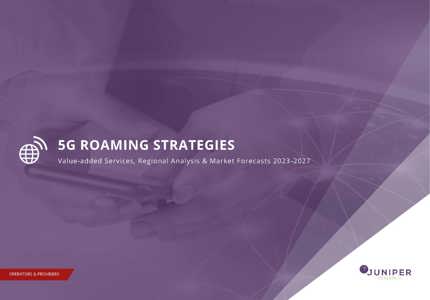How Mobile Roaming Can Recover from COVID-19
Roaming refers to the use of mobile devices, including phones and IoT-connected devices, outside the range of a home network. Whilst roaming, devices connect to another available network, in order to provide end users with continued services. Usually, the summer months are a crucial time for mobile operators in terms of revenue, with often more than a twofold increase in roaming traffic during the summer holiday season.
However, during 2020, the international travel restrictions and lockdown procedures enforced because of the COVID-19 pandemic significantly curtailed the demand for mobile roaming services, with fewer subscribers travelling abroad for business and leisure purposes. Indeed, we forecast that the total number of mobile roaming subscribers has decreased from 894 million in 2019, to 243 million in 2020.
Remedial plans are therefore sorely needed for operators to survive the long-lasting impacts of the pandemic, as roaming revenue loss experienced by mobile operators during the pandemic is not a temporary shortfall that can be recuperated.
One such plans is forging alliances between operators. Roaming via bilateral partnerships and alliances increases the possibilities of monetisation by presenting viable revenue models for all the members of the value chain. This opportunity also exists for smaller operators and MVNOs (Mobile Virtual Network Operators), in order to form alliances and partnerships with other operators which could not otherwise offer roaming services due to their lack of scale. As a result, enterprise customers are increasingly being offered flexible models, thereby driving usage while roaming, with major alliance groups focusing on multinational corporations.
Operator should also invest on developing technologies, such as LTE-M Roaming, a cellular technology designed to support the needs of applications within the IoT (Internet of Things), as well as enabling M2M (Machine-to-Machine) communications. It is also possible for operators to offer support of voice functionality over LTE networks, referred to as VoLTE. With 2G and 3G sunsetting underway, corporations must consider which fallback technology is best suited to their business needs. It is therefore important for operators to implement VoLTE roaming to ensure the smooth transition of voice services for consumers and provide them with a high-quality experience, even whilst travelling overseas. There are however some obstacles which are slowing VoLTE’s adoption process, particularly the lack of a clear monetisation model for the technology. These obstacles will need to be overcome in order to encourage VoLTE roaming adoption.
The implementation of 5G roaming agreements will also lead to a range of benefits, including new opportunities for globally connected IoT businesses and high-speed/low-latency data transfer, providing subscribers with a smoother experience. Once again, however, there operators are faced with several obstacles. Indeed, the provision of seamless 5G roaming relies heavily on network operators. Whilst an increasing number of operators are offering commercial NSA solutions, there is a marked lack of SA infrastructure that would provide the basis for 5G roaming capabilities. Until more operators invest in SA infrastructure, 5G roaming cannot become a commercial reality.
Another limiting factor to the establishment of 5G roaming agreements is the cost associated with implementing SA networks. The deployment of new infrastructure requires major investment from network operators and may not be conducive for network operators during this time of economic uncertainty.
Furthermore, once 5G roaming services are in place, operators and enterprises must implement solutions that minimise the risk of attacks on connected networks. As connected networks increase in size, the number of points vulnerable to cyberattacks also increase.
Yet, there is clearly demand for 5G roaming, and operators must continue with network roll-outs despite additional pressures felt as a result of the pandemic. This will enable operators to provide subscribers with a high-quality service, whilst also capitalising on the opportunity to make a profit.
Latest research, whitepapers & press releases
-
 ReportDecember 2025
ReportDecember 2025AI Agents for Customer Experience Platforms Market: 2025-2030
Our comprehensive AI Agents for Customer Experience Platforms research suite comprises detailed assessment of a market that is set to disrupt mobile communications. It provides stakeholders with insight into the key opportunities within the AI agents for customer experience platforms market over the next two years.
VIEW -
 ReportDecember 2025Fintech & Payments
ReportDecember 2025Fintech & PaymentseCommerce Fraud Prevention Market: 2025-2030
Our eCommerce Fraud Prevention research suite provides a detailed and insightful analysis of this evolving market; enabling stakeholders from financial institutions, law enforcement agencies, regulatory bodies and technology vendors to understand future growth, key trends, and the competitive environment.
VIEW -
 ReportNovember 2025Telecoms & Connectivity
ReportNovember 2025Telecoms & ConnectivityeSIMs & iSIMs Market: 2025-2030
Juniper Research’s eSIMs and iSIMs research suite offers insightful analysis of a market set to experience significant growth in the next five years. The research suite provides mobile network operators (MNOs), original equipment manufacturers (OEMs), and eSIM management and platforms vendors with intelligence on how to capitalise on the market growth, and guidance on how eSIM-only devices and sensors, SGP.42, in-factory provisioning, and iSIMs will change the competitive landscape.
VIEW -
 ReportNovember 2025Fintech & Payments
ReportNovember 2025Fintech & PaymentsModern Card Issuing Platforms Market: 2025-2030
Our Modern Card Issuing Platforms Market research suite provides a detailed and insightful analysis of this evolving market; enabling stakeholders from banks, financial institutions, fintech companies, and technology vendors to understand future growth, key trends, and the competitive environment.
VIEW -
 ReportNovember 2025Fintech & Payments
ReportNovember 2025Fintech & PaymentsDigital Wallets Market: 2025-2030
Our digital wallets research suite provides detailed analysis of this rapidly changing market; allowing digital wallet providers to gain an understanding of key payment trends and challenges, potential growth opportunities, and the competitive environment.
VIEW -
 ReportOctober 2025Fintech & Payments
ReportOctober 2025Fintech & PaymentsDigital Identity Market: 2025-2030
Juniper Research’s Digital Identity research suite provides a comprehensive and insightful analysis of this market; enabling stakeholders, including digital identity platform providers, digital identity verification providers, government agencies, banks, and many others, to understand future growth, key trends, and the competitive environment.
VIEW
-
 WhitepaperDecember 2025Telecoms & Connectivity
WhitepaperDecember 2025Telecoms & ConnectivityHuman + AI: Drivers of Customer Experience AI Agents in 2026
Our complimentary whitepaper, Human + AI: Drivers of Customer Experience AI Agents in 2026, examines the key drivers of the AI agents for customer experience platforms market in 2025.
VIEW -
 WhitepaperDecember 2025Fintech & Payments
WhitepaperDecember 2025Fintech & PaymentsBeyond Chargebacks: The True Cost of Fraud for Digital Commerce
Our complimentary whitepaper, Beyond Chargebacks: The True Cost of Fraud for Digital Commerce, examines the state of the eCommerce fraud prevention market; considering the impact of evolving digital fraud strategies, including key trends such as identity theft, account takeovers, chargebacks, policy abuse and friendly fraud.
VIEW -
 WhitepaperNovember 2025Telecoms & Connectivity
WhitepaperNovember 2025Telecoms & ConnectivityeSIM-only Devices: The Impact on Operators, Consumers, and IoT
Our complimentary whitepaper, eSIM-only Devices: The Impact on Operators, Consumers, and IoT, explores the challenges and opportunities for the three segments, with a particular focus on eSIM-only smartphones and SGP.42.
VIEW -
 WhitepaperNovember 2025Fintech & Payments
WhitepaperNovember 2025Fintech & PaymentsUnlocking the Next Stage of Growth for Modern Card Issuing Platforms
This free whitepaper analyses key trends shaping the modern card issuing space, and the ways in which modern card issuing platforms can capture growth.
VIEW -
 WhitepaperNovember 2025Fintech & Payments
WhitepaperNovember 2025Fintech & PaymentsTop 10 Fintech & Payments Trends 2026
Fintech is evolving fast. From stablecoins to agentic AI, our annual guide reveals the shifts redefining payments, digital identity, and the future of money in 2026. Download your copy today.
VIEW -
 WhitepaperNovember 2025Fintech & Payments
WhitepaperNovember 2025Fintech & PaymentsDigital Wallets: Empowering Financial Inclusivity
Our complimentary whitepaper, Digital Wallets: Empowering Financial Inclusivity, examines the state of the digital wallets market; considering the impact of digital wallets on different geographies, how they are shaping the modern payments landscape through lower transaction fees and promoting financial inclusivity for underbanked populations, and how they are competing with established payment methods.
VIEW
-
IoT & Emerging Technology
Juniper Research Unveils Top 10 Emerging Tech Trends to Watch in 2026
January 2026 -
Fintech & Payments
Digital Identity App Usage to Hit 6.2 Billion by 2030, Driven by Shift to Decentralised Models
December 2025 -
Telecoms & Connectivity
Travel eSIM Margins Under Pressure as Revenue per Gigabyte Falls 10% Globally in Two Years
December 2025 -
Telecoms & Connectivity
AI Agents to Power 1,000% More Customer Interactions for Enterprises Globally by 2027
December 2025 -
IoT & Emerging Technology
Global D2C Revenue Set for $370 Million Surge, But Satellite Operators Should Not Chase Full MNO Status
December 2025 -
Fintech & Payments
Digital Goods Fraud to Cost eCommerce Merchants $27 Billion Globally by 2030 as AI Tools Accelerate Attacks
December 2025





















